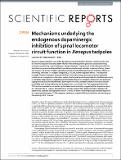Files in this item
Mechanisms underlying the endogenous dopaminergic inhibition of spinal locomotor circuit function in Xenopus tadpoles
Item metadata
| dc.contributor.author | Picton, Laurence David | |
| dc.contributor.author | Sillar, Keith Thomas | |
| dc.date.accessioned | 2016-10-27T14:30:37Z | |
| dc.date.available | 2016-10-27T14:30:37Z | |
| dc.date.issued | 2016-10-20 | |
| dc.identifier | 246705962 | |
| dc.identifier | 8c2c3d06-95f4-4d3e-b952-4c826608f478 | |
| dc.identifier | 84992343557 | |
| dc.identifier | 000386181500001 | |
| dc.identifier.citation | Picton , L D & Sillar , K T 2016 , ' Mechanisms underlying the endogenous dopaminergic inhibition of spinal locomotor circuit function in Xenopus tadpoles ' , Scientific Reports , vol. 6 , 35749 . https://doi.org/10.1038/srep35749 | en |
| dc.identifier.issn | 2045-2322 | |
| dc.identifier.other | ORCID: /0000-0003-0171-3814/work/64393759 | |
| dc.identifier.uri | https://hdl.handle.net/10023/9714 | |
| dc.description | This work was supported by the Biotechnology and Biological Science Research Council (BBSRC) [grant number BB/J01446X/1]. | en |
| dc.description.abstract | Dopamine plays important roles in the development and modulation of motor control circuits. Here we show that dopamine exerts potent effects on the central pattern generator circuit controlling locomotory swimming in post-embryonic Xenopus tadpoles. Dopamine (0.5–100 μM) reduced fictive swim bout occurrence and caused both spontaneous and evoked episodes to become shorter, slower and weaker. The D2-like receptor agonist quinpirole mimicked this repertoire of inhibitory effects on swimming, whilst the D4 receptor antagonist, L745,870, had the opposite effects. The dopamine reuptake inhibitor bupropion potently inhibited fictive swimming, demonstrating that dopamine constitutes an endogenous modulatory system. Both dopamine and quinpirole also inhibited swimming in spinalised preparations, suggesting spinally located dopamine receptors. Dopamine and quinpirole hyperpolarised identified rhythmically active spinal neurons, increased rheobase and reduced spike probability both during swimming and in response to current injection. The hyperpolarisation was TTX-resistant and was accompanied by decreased input resistance, suggesting that dopamine opens a K+ channel. The K+ channel blocker barium chloride (but not TEA, glybenclamide or tertiapin-Q) significantly occluded the hyperpolarisation. Overall, we show that endogenously released dopamine acts upon spinally located D2-like receptors, leading to a rapid inhibitory modulation of swimming via the opening of a K+ channel. | |
| dc.format.extent | 10996607 | |
| dc.language.iso | eng | |
| dc.relation.ispartof | Scientific Reports | en |
| dc.subject | RC0321 Neuroscience. Biological psychiatry. Neuropsychiatry | en |
| dc.subject | NDAS | en |
| dc.subject | BDC | en |
| dc.subject.lcc | RC0321 | en |
| dc.title | Mechanisms underlying the endogenous dopaminergic inhibition of spinal locomotor circuit function in Xenopus tadpoles | en |
| dc.type | Journal article | en |
| dc.contributor.institution | University of St Andrews. School of Psychology and Neuroscience | en |
| dc.contributor.institution | University of St Andrews. Institute of Behavioural and Neural Sciences | en |
| dc.identifier.doi | 10.1038/srep35749 | |
| dc.description.status | Peer reviewed | en |
This item appears in the following Collection(s)
Items in the St Andrews Research Repository are protected by copyright, with all rights reserved, unless otherwise indicated.

